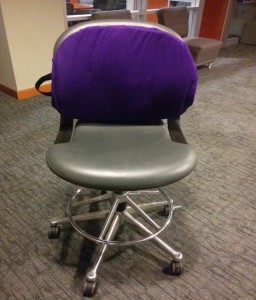Designers: Gaurav Bhat, Neeraja Nagarajan, Tara Porter, Pranali Tambe
Supervising Professor: Larry Bohs
INTRODUCTION
Our client, who has spina bifida and osteoporosis, has difficulty performing weight-bearing exercises because she uses a wheelchair. The goal of this project was to develop a device that will improve spine bone density for seated users. We built a novel vibrational therapy device that uses high-frequency, low-magnitude vibrations to stimulate bone cells in the spine. It consists of a cushion with implanted vibrational motors that can be attached to a chair back. The device is easy to use and fits well into our client’s daily routine. Use of the device will hopefully prevent bone loss and stimulate bone growth over time.
SUMMARY OF IMPACT
The Osteovibe (Figure 1) provides low intensity vibrations at a magnitude of less than 1 g and frequency of 60 Hz. These vibrations activate the osteoblasts to lay more bone and thus improve spine bone density over time. The device is used regularly for 20 minutes duration, twice a day. Over time this will help improve the spine bone density. Our client feels very comfortable with the device. She said,” The device is user friendly and conforms nicely to my back.” Our Physical Therapists said,” the device is ergonomic and will help the client maintain proper back alignment.”
TECHNICAL DESCRIPTION
The device consists of a chair back, six vibration motors, an electronic circuit that controls the motors and an electronic casing.
The six Univibe 12 mm vibration motor-20 mm type are placed along the centreline of the chair back. Each motor’s offset mass is covered with a custom, 3D-printed protective cap. The motors are mounted onto a square piece of foam for dampening effect. A layer of foam is placed on top of the motors. This is covered with a thin layer of fabric.
On the back is a 6” X 2.5”X 2” electronic casing enclosing the circuit. The circuit consists of a PIC microcontroller that controls the motor vibrations for the stipulated time of 20 minutes. This is connected to a 1.3 kΩ resistor which is connected to a Darlington pair that is then connected to a diode. The motors are connected in parallel to the diode. A 5.6 Ω resistor is placed in the circuit to maintain a constant voltage of 2.34 V across the motors. The circuit can be turned on with a switch that is placed at the corner of the chair back for easy accessibility. The circuit is powered by 3 rechargeable AA batteries, each giving 1.5 V. The batteries can be removed easily from the battery holder and charged using a wall charger.
The device can be attached to any chair using the two Velcro straps. For easy transport, a Velcro handle is provided. The cost of the Osteovibe is $160.

